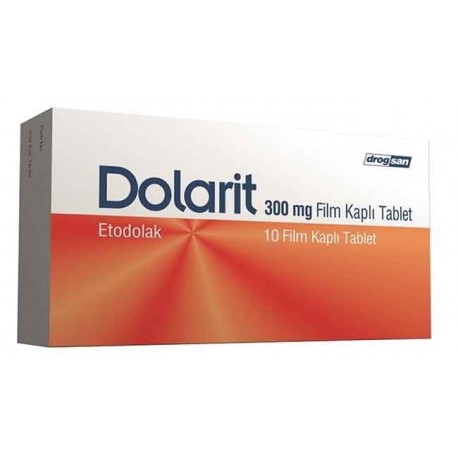 View larger
View larger Dolarit (Etodolac, Generic Lodine, Lodine XL) Tablets
New product
BUY MORE PAY LESS
| Quantity | Discount | |
|---|---|---|
| 2 | 5% | |
| 3 | 10% | |
| 4 | 15% | |
| 5 | 20% |
Volume discounts
| Quantity | Discount | You Save |
|---|---|---|
| 2 | 5% | Up to $2.90 |
| 3 | 10% | Up to $8.70 |
| 4 | 15% | Up to $17.40 |
| 5 | 20% | Up to $29.00 |
More info
Active ingredient
400 mg Etodolac in each film-coated tablet.
Excipients
Microcrystalline cellulose, Lactose monohydrate, Polyvinyl pyrrolidone, Sodium starch glycolate, Colloidal silicon dioxide, Magnesium stearate, Polyvinyl alcohol, Polyethylene glycol, Tribasic calcium phosphate, Talc, Titanium dioxide.
What is ETODOLAC and what is it used for?
ETODOLAC ; It is a film-coated tablet containing etodolac as an active ingredient. ETODOLAC is in the group of drugs (anti-inflammatory without steroids) used in the treatment of conditions characterized by inflammation.
ETODOLAC ; signs and symptoms of osteoarthritis, rheumatoid arthritis, ankylosing spondylitis and acute gouty arthritis
with treatment of symptoms, acute musculoskeletal pain, postoperative (postoperative) pain,
It is indicated for the treatment of short and long term pain such as dysmenorrhoea (painful menstruation).
3. How to use ETODOLAC ?
Instructions for proper use and dose / frequency of administration
Do not take more than the recommended dose and take longer than your doctor's advice.
Application route and method
ETODOLAC is taken orally with a full glass of water, take according to your doctor's instructions.
Different age groups
Use in children
Use in the elderly
Use in the elderly
ETODOLAC should be used with caution in elderly patients; They may be more susceptible to stomach bleeding and kidney problems.
Special use cases
Kidney or liver failure:
It can be used in mild to moderate liver and kidney failure. It should not be used in severe liver and kidney failure.
If you have an observation that the effect of ETODOLAC is too strong or weak, talk to your doctor or pharmacist.
If you use more ETODOLAC than you should
Signs (symptoms); Symptoms may include decreased urination, loss of consciousness, seizures, severe dizziness or lightheadedness, severe nausea or abdominal pain, slow or trouble breathing, unusual bleeding or bruising, vomiting such as coffee grounds. If you have used more than you should use from DOLARIT, talk to a doctor or pharmacist.
If you forgot to use ETODOLAC
If you have neglected to take a dose of ETODOLAC and are taking it regularly, take the missed dose as soon as possible. Skip the missed dose if it is almost time for the next dose. Then continue to take it regularly.
4. What are the possible side effects?
Like all medicines, people who are sensitive to the ingredients of ETODOLAC may have side effects.
If any of the following occur, stop using ETODOLAC and IMMEDIATELY inform your doctor or go to the nearest emergency department:
• Serious stomach ulcers or bleeding may occur with the use of ETODOLAC . Taking high doses or for prolonged periods of time, smoking or drinking alcohol increases the risk of these side effects. Taking DOLARIT with food does not reduce the risk of these effects. Severe stomach or back pain; if you have black stool (melena); if you vomit like blood or coffee grounds; or if you are experiencing unusual weight gain or swelling, contact your doctor or the emergency room immediately.
• Severe allergic reactions (skin rash; hives; itching; difficulty breathing; chest tightness; swelling of the mouth, face, lips, or tongue).
These are all very serious side effects.
If you have one of these, it means you have a serious allergy to ETODOLAC . You may need urgent medical attention or hospitalization.
All of these very serious side effects are very rare.
If you notice any of the following, inform your doctor immediately or contact the emergency department of your nearest hospital:
Bloody or black stools (melena)
Changes in the amount of urine
Chest pain
Confusion
Dark urine
Depression
Fainting
Fast or irregular heartbeat
Fever, chills or prolonged (persistent) sore throat
Mental or behavioral changes
Arm or leg numbness
• One-sided weakness
Red, swollen, raised, or peeling skin
Ringing in the ears
• Crises
Severe headache or dizziness
Severe or prolonged (persistent) abdominal pain or nausea
Severe vomiting
Shortness of breath
Sudden or unexplained weight gain
Swelling of the hands, legs, or feet
Unusual bruising or bleeding
Unusual joint or muscle pain
Unusual tiredness or weakness
Vision or speech changes
Vomiting like coffee grounds
Yellowing of the skin or eyes
High blood pressure as a sign of kidney failure or toxicity
Bloody urine
Some allergic symptoms
All these are serious side effects. Immediate medical attention may be required.
Serious side effects are very rare.
If you notice any of the following, tell your doctor:
Constipation
• Diarrhea
Dizziness
• Gas
• Headache
Heartburn
• Nausea
Stomach discomfort
Blocked nose
• Weakness

